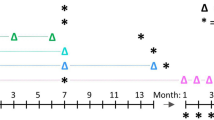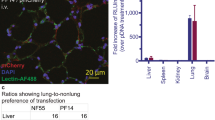Abstract
Pulmonary gene therapy may ultimately cure diseases such as cystic fibrosis, α1-antitrypsin deficiency, lung cancer and pulmonary hypertension. Efficient expression of delivered genes in target cell types is essential for the achievement of this goal. To this end, re-administration of viral vectors may be required (1) to increase the percentage of transduced airway epithelial cells, (2) to direct gene transfer to individual lobes during successive delivery sessions or (3) to boost attenuated expression over time. Immune responses to viral proteins or viral-encoded proteins are the greatest barrier to repeated vector administration.
This is a preview of subscription content, access via your institution
Access options
Subscribe to this journal
Receive 12 print issues and online access
$259.00 per year
only $21.58 per issue
Buy this article
- Purchase on Springer Link
- Instant access to full article PDF
Prices may be subject to local taxes which are calculated during checkout



Similar content being viewed by others
References
Kawai T, Akira S . Toll-like receptor and RIG-I-like receptor signaling. Ann N Y Acad Sci 2008; 1143: 1–20.
Sinn PL, Arias AC, Brogden KA, McCray Jr PB . Lentivirus vector can be readministered to nasal epithelia without blocking immune responses. J Virol 2008; 82: 10684–10692.
Halbert CL, Miller AD, McNamara S, Emerson J, Gibson RL, Ramsey B et al. Prevalence of neutralizing antibodies against adeno-associated virus (AAV) types 2, 5, and 6 in cystic fibrosis and normal populations: Implications for gene therapy using AAV vectors. Hum Gene Ther 2006; 17: 440–447.
Bangari DS, Mittal SK . Current strategies and future directions for eluding adenoviral vector immunity. Curr Gene Ther 2006; 6: 215–226.
Limberis MP, Wilson JM . Adeno-associated virus serotype 9 vectors transduce murine alveolar and nasal epithelia and can be readministered. Proc Natl Acad Sci USA 2006; 103: 12993–12998.
Kwon I, Schaffer DV . Designer gene delivery vectors: molecular engineering and evolution of adeno-associated viral vectors for enhanced gene transfer. Pharm Res 2008; 25: 489–499.
Eto Y, Yoshioka Y, Mukai Y, Okada N, Nakagawa S . Development of PEGylated adenovirus vector with targeting ligand. Int J Pharm 2008; 354: 3–8.
Price AR, Limberis MP, Wilson JM, Diamond SL . Pulmonary delivery of adenovirus vector formulated with dexamethasone-spermine facilitates homologous vector re-administration. Gene Therapy 2007; 14: 1594–1604.
Brunetti-Pierri N, Ng P . Progress towards the clinical application of helper-dependent adenoviral vectors for liver and lung gene therapy. Curr Opin Mol Ther 2006; 8: 446–454.
Brunetti-Pierri N, Ng T, Iannitti DA, Palmer DJ, Beaudet AL, Finegold MJ et al. Improved hepatic transduction, reduced systemic vector dissemination, and long-term transgene expression by delivering helper-dependent adenoviral vectors into the surgically isolated liver of nonhuman primates. Hum Gene Ther 2006; 17: 391–404.
Koehler DR, Martin B, Corey M, Palmer D, Ng P, Tanswell AK et al. Readministration of helper-dependent adenovirus to mouse lung. Gene Therapy 2006; 13: 773–780.
Vandenberghe LH, Wang L, Somanathan S, Zhi Y, Figueredo J, Calcedo R et al. Heparin binding directs activation of T cells against adeno-associated virus serotype 2 capsid. Nat Med 2006; 12: 967–971.
Sumner-Jones SG, Gill DR, Hyde SC . Lack of repeat transduction by recombinant adeno-associated virus type 5/5 vectors in the mouse airway. J Virol 2007; 81: 12360–12367.
De BP, Heguy A, Hackett NR, Ferris B, Leopold PL, Lee J et al. High levels of persistent expression of alpha1-antitrypsin mediated by the nonhuman primate serotype rh.10 adeno-associated virus despite preexisting immunity to common human adeno-associated viruses. Mol Ther 2006; 13: 67–76.
Levine BL, Humeau LM, Boyer J, MacGregor RR, Rebello T, Lu X et al. Gene transfer in humans using a conditionally replicating lentiviral vector. Proc Natl Acad Sci USA 2006; 103: 17372–17377.
Buckley SM, Howe SJ, Sheard V, Ward NJ, Coutelle C, Thrasher AJ et al. Lentiviral transduction of the murine lung provides efficient pseudotype and developmental stage-dependent cell-specific transgene expression. Gene Therapy 2008; 15: 1167–1175.
Brown BD, Sitia G, Annoni A, Hauben E, Sergi LS, Zingale A et al. In vivo administration of lentiviral vectors triggers a type I interferon response that restricts hepatocyte gene transfer and promotes vector clearance. Blood 2007; 109: 2797–2805.
Excoffon KJ, Koerber JT, Dickey DD, Murtha M, Keshavjee S, Kaspar BK et al. Directed evolution of adeno-associated virus to an infectious respiratory virus. Proc Natl Acad Sci USA 2009; 106: 3865–3870.
Brown BD, Cantore A, Annoni A, Sergi LS, Lombardo A, Della Valle P et al. A microRNA-regulated lentiviral vector mediates stable correction of hemophilia B mice. Blood 2007; 110: 4144–4152.
Kelly EJ, Russell SJ . MicroRNAs and the regulation of vector tropism. Mol Ther 2009; 17: 409–416.
Author information
Authors and Affiliations
Corresponding author
Rights and permissions
About this article
Cite this article
Sinn, P., Burnight, E. & McCray, P. Progress and Prospects: prospects of repeated pulmonary administration of viral vectors. Gene Ther 16, 1059–1065 (2009). https://doi.org/10.1038/gt.2009.87
Received:
Revised:
Accepted:
Published:
Issue Date:
DOI: https://doi.org/10.1038/gt.2009.87
Keywords
This article is cited by
-
Intrapulmonary Versus Nasal Transduction of Murine Airways With GP64-pseudotyped Viral Vectors
Molecular Therapy - Nucleic Acids (2013)
-
Gene therapy: light is finally in the tunnel
Protein & Cell (2011)
-
Neonatal Gene Therapy of Glycogen Storage Disease Type Ia Using a Feline Immunodeficiency Virus–based Vector
Molecular Therapy (2010)



